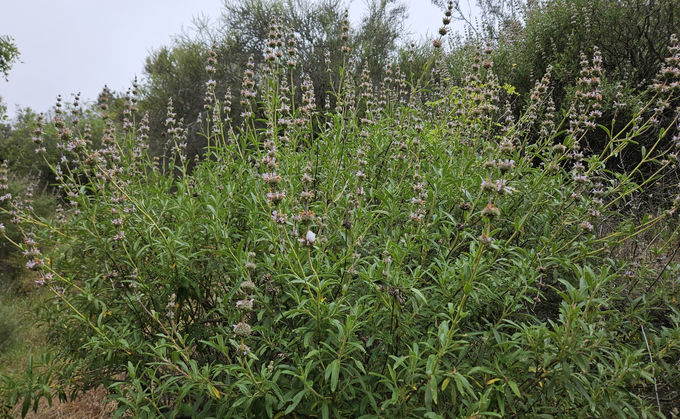Nursery Hours for October-March
Thursday-Saturday: 9:00-5:00 • Wednesday/Sunday: By Appointment
🌲🌲🌲Holiday Schedule🌲🌲🌲
Thanksgiving: Thursday & Friday CLOSED • Saturday OPEN 9:00-5:00
Christmas: 12/23/2025-01/07/2026 CLOSED
Need a gift for the plant person in your life? We have gift cards!
Black Sage
Salvia melifera
true
1 gallon
Black Sage
In stock
3'x3'
Sizes:
Black Sage – Salvia mellifera
Black sage is the most common sage in California and northern Baja California, and one of the keystone species of the coastal sage scrub plant community. Black sages grow quickly, mounding to 3 to 6 feet in height and as wide. The plant has attractive dark green leaves, 1–3 inches long. It is semi-deciduous; leaves may curl or drop during summer drought. The plant is highly aromatic.
White to pale blue-lavender flowers occur in clusters at any time of the year, with heaviest bloom typically in spring. The flowers are an important food source for bees, butterflies (including the monarch), and hummingbirds, and the seeds provide a valuable food source for quail, towhee, and other seed-eating birds.
According to Calscape, there are a few spots locally of black sage, but it is not considered a widespread “local native” for the Coachella Valley or lower desert floor. It is, however, common in the lower Mojave Desert and nearby foothill regions. In my garden, a specimen planted this spring is showing surprising resilience — despite the normal stress of August heat, it appears to be surviving and adapting well.
Wildlife Value
Black Sage supports a rich variety of wildlife, especially pollinators and seed-eating birds.
Host Plant: Supports various moth and butterfly larvae, including species in the skipper and sphinx moth families.
Nectar Source: Monarch (Danaus plexippus), Sphinx moths (Sphingidae), Marine Blue (Leptotes marina), Reakirt’s Blue (Echinargus isola), various native solitary bees, honeybees.
Bird Resources: Caterpillars, seeds, nectar, and nesting habitat.
Bird Species: Hummingbirds (Anna’s Calypte anna and Costa’s Calypte costae — with Costa’s favoring native sources), White-crowned Sparrow (Zonotrichia leucophrys), Gambel’s Quail (Callipepla gambelii), California Towhee (Melozone crissalis).
Bees: Attracts a wide variety of native bees and honeybees, including specialist Anthophora and Osmia species where ranges overlap.
Plant Care
Native region:
Local Native; Mojave Desert
Water needs:
Low - Moderate
Exposure:
Filtered Sun
Mature size:
3'x3'
Growth rate:
Moderate
Flower color:
White; Blue; Violet
Flower season:
Winter; Spring; Summer
Pruning:
Overgrown or leggy shrubs can be cut back in the late fall to reduce size and
increase density.
Cold Hardiness:
15 Degrees
Nectar-producing:
Yes
Attracts pollinators:
Yes
Nighttime pollinators:
Yes
Butterflies or Moths:
Yes
Monarchs:
Yes
Larval host:
No
Bees:
Yes
Bats:
No
Birds:
Yes
Nest site:
Yes
Nest materials:
No
Rabbit-resistant:
No
Tortoises:
No
Growing Plants in the Desert — Important Information
The information presented here is, to the best of my knowledge, accurate and based on reliable research, personal experience in my own garden, observations from other gardens I’ve visited, and time spent studying plants in their native habitats. I always welcome your feedback and experiences to help me continue educating others!
Cacti:
In my experience, cacti are much happier in filtered shade here in the low desert of the Coachella Valley. Their colors are more vibrant and they tend to bloom more profusely, especially the non-native varieties. If you look closely at how our native barrel cactus and beavertail prickly pear grow in the wild, you’ll often find them tucked among rocks or beneath the shelter of creosote and other shrubs.
⚠️ A note of caution: Cacti and succulents are often illegally collected from the wild, which not only damages plant populations but also disturbs entire ecosystems. In some cases, wild populations of cacti have even gone extinct because of this practice. When purchasing these plants, always be sure they’ve been legally obtained. Look for nursery-grown stock or plants with a native plant certification, and keep that documentation for your records.
Light Requirements:
In our desert (Sonoran/Colorado), “full sun” doesn’t always mean what you might think. Many so-called full-sun plants benefit from and actually appreciate some late-afternoon filtered light—especially during the intense summer months.



